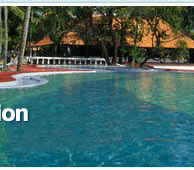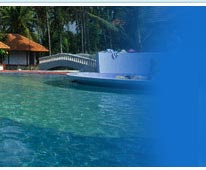 ACID INHIBITORS
ACID INHIBITORS
CHEMIKA 213 Spl is an organic, cationic, moderately, foaming, liquid acid
inhibitor designed to inhibit the attack of Hydrochloric Acid on Copper,
Brass, Iron and steel, during industrial cleaning and pickling operations.
CHEMIKA 213 Spl is non-toxic and the formulation does not contain Arsenic,
Antimony, Cadmium, Lead, Mercury or CFCs.
 Benefits
Benefits
- CHEMIKA 213 Special works even in low dosage and elevated
temperatures
- It is very stable at elevated temperatures and none of its
components are lost by decomposition
- It is always in solution during the cleaning as it does not
salt-out. So uniform and total protection is assured
- CHEMIKA 213 Special does not stain metal surfaces
- CHEMIKA 213 Special gives protection to any type of steel,
copper, brass upto 120 C.
- CHEMIKA 213 Special is completely miscible with water and acids
|
 Applications and Dosage
Applications and Dosage
- The addition of CHEMIKA 213 Special to Hydrochloric Acid solution
provides maximum protection to equipment during the removal of lime
deposits or water scale from plant boilers, piping systems and
evaporating equipment, heating and cooling systems.
- CHEMIKA 213 Special is recommended at 1-1.5 ltr per 100 ltr of
30-34% Hydrochloric Acid upto cleaning temperature of 60-80 C
- CHEMIKA 213 Special is recommended at 2-2.5 ltr per 100 ltr of
30-34% Hydrochloric Acid upto cleaning temperature of 90-120 C
|
 Handling, Storage and Precautions
Handling, Storage and PrecautionsShelf life of CHEMIKA 213 Spl is over 1 year (at 5 to 50
C storage). Avoid contact with skin. In case of contact, wash with fresh
water. Do not swallow.
 Packing
PackingCHEMIKA 213 Spl is available in 50 kg & 200
kg HDPE drums.
* For Other range Acid Inhibitors / Corrosion inhibitors, please contact
us *
 WATER ABSORBENT POLYMER
WATER ABSORBENT POLYMER
Superabsorbents are synthetic polymers with water retention properties for
a variety of uses. WATERLOCK is supplied as white powder. In contact with
water the polymer hydrates and becomes a transparent gel. Each particle
however remains separate and can absorb up to 500 times its weight of water
resulting in a five hundred fold increase in particle size. Unlike most
substances, which hydrate, the hydration are fully reversible and the
particle can return to its original size. The water can be removed by a
variety of methods such as heating or high pressure. The polymer can thus
act as water reservoir, that can be filled and emptied many times.
WATERLOCK will absorb upto 800 times its own weight of distilled
water. In water containing salts and minerals the absorption potential will
vary. WATERLOCK is crosslinked polyacrylamide copolymer, that
absorbs water. Its action can be compared to a sponge except that while a
sponge retains its size with or without water, WATERLOCK swells and
shrinks as it hydrates and dehydrates. It thus functions as a water
reservoir. The absorption capacity is variable depending on the quality of
the water.
 |
| Distilled water |
About 800 times its weight. |
| Water with 1000 ppm of NaCl
|
About 400 times its weight. |
|
 |
The pH of the water will have little
effect on the absorption potential within the range of 5 to 10. It must be
remembered that the pH is not a measure of the salt concentration and a
neutral pH does not necessarily mean that the water is not high in salts. In
an eight per cent calcium chloride solution swelling is reduced by a factor
of ten. In the presence of high levels of iron and aluminium an external
skin can be formed on the polymer, which greatly reduces the water retention
capacity.
WATERLOCK is virtually unaffected by short exposure to boiling water. After
prolonged exposure a certain amount of hydrolysis of the polymer may occur,
especially at high pH. This hydrolysis will have a limited effect on the
water absorbing capacity of the polymer. Water held by the polymer is fixed
and not sensitive to removal by pressure or centrifugal forces until above 5
bars is exerted.
The stability of the polymer to bacterial degradation is variable depending
on number of factors. In aerobic condition little degradation is observed
and the polymer may be expected to function well for at least five years. In
anaerobic conditions the polymer can be broken down by the ferrous ions
created by the action of sulphate reducing bacteria.
 Mechanism
Mechanism To understand how this polymer functions to absorb
water, we can consider a simplified model of a single molecule. Each
molecule can be represented by parallel rows of the principal atoms with
periodical bridging links between them. When water comes into contact with
these rows an electrical repulsion between rows is generated, rather as in
the poles of magnet, and the rows move apart. This draws more water into the
molecule and the rows move further apart. This results in a rapid swelling
of each particle. The water can be removed from the polymer either by
evaporation or by exerting pressure beyond 5 bars. The molecule on losing
water contracts to its original size. This swell and shrink cycle can be
repeated indefinitely.
 Technical Data
Technical Data Sodium polyacrylate
Sodium polyacrylate
 |
| FORM - dry |
Crystalline white powder / granules |
| FORM - wet |
Transparent gel |
|
 |
 Particle Size
Particle Size
 Water Absorption
Water Absorption
 |
| With distilled water |
800 g for 1 g |
| With Sea Water |
40 g for 1 g |
| pH of absorbed water |
Neutral |
| Density |
1.08 |
| Bulk Density |
0.85 |
| Time to hydrate to 60% |
60 minutes |
| Hydration /Dehydration |
Reversible |
| Stability of Dry product |
5 years |
| Stability of Wet product |
4 years |
| Decomposition in sunlight |
6 months |
| Available water |
95% approx. |
|
 |
 Applications
ApplicationsSome of the application where WATERLOCK
is Currently being used includes:
- Diapers and Sanitary napkins.
- Soil water capacity enhancement.
- Gel packs(used for transpiration of medicines, vaccines, etc.
|
 CALCIUM GLUCONATE
CALCIUM GLUCONATE
Calcium gluconate is a mineral
supplement. Calcium gluconate is absorbed fairly well by the body.
Apart from the well-known fact that calcium is necessary for bone formation
and maintenance, calcium also regulates heart rhythm, nerve transmission,
and muscle contraction. Calcium can also lower blood pressure by up to 10
points, relieve insomnia, nervousness, and irritability, and relieve muscle
cramping, especially in the lower extremities.
Gel preparations of calcium gluconate are used to treat hydrofluoric acid
burns
 Specifications:
Specifications:
 |
| Characteristic |
Specification |
| Assay (%) |
98.0 – 99.0% |
| Chloride % |
< 0.02 |
| Sulphate % |
< 0.01 |
| Arsenic % |
< 0..002 |
| Heavy Metal |
< 0.001 |
| Sucrose or reducing agent % |
Negative |
| Loss on drying |
< 0.5 |
| pH |
6.0 – 8.0 |
|
 |
 WHITE DEXTRINE
WHITE DEXTRINE
 Acid Inhibitors Equivalent To Rodine
Acid Inhibitors Equivalent To Rodine
Characteristic achieves optimum corrosion inhibition without heavy metals eliminates or minimises acid feed controls deposition and scale with copolymer.
Description and use ap series is a synergistic blend of phosphonate and patented calcium phosphate inhibitor, designed to control corrosion and scale formation in open evaporative cooling systems. The blend is specifically designed to obtain optimum results with the minimal amount of total phosphate, under a given set of condition
 Isothiazolone
Isothiazolone
For sticky mud stripping agent.
Voted to increase the concentration of 150-300mg /l isothiazolone off by algae and bacteria proteins into the key role in the killing. Isothiazolone in contact with the micro-organisms that can quickly and irreversibly inhibit its growth, resulting in the death of microbial cells, it is common for bacteria, fungi, algae, and so has a strong role in killing and suppression. Efficient killing, with no residue, safe operation, good compatibility, stability, use and low cost. With chlorine and the majority of anions and cations and nonionic surfactant with immiscibility. High-dose, isothiazolone biological sticky mud off a significant effect. Isothiazolone is a broad-spectrum, high efficiency, low toxicity, non-oxidizing biocide. Widely used in oil fields, paper, chemicals, cutting oil, leather, ink, dyes, and leather industries.
 DBNPA
DBNPA
Cas No. : 10222-01-2 Appearance : White crystalline powder Assay : Min99% Moisture : 0.5% It is widely used as biocide Applications It is widely used as biocide and preservatives for paints, cosmetics, paper-making.
 ATMP Chemical
ATMP Chemical
HEDP is an organophosphoric acid corrosion inhibitor. It can chelate with Fe, Cu, and Zn ions to form stable chelating compounds.It can dissolve the oxidized materials on these metals’ surfaces. HEDP shows excellent scale and corrosion inhibition effects under temperature 250°C. HEDP has good chemical stability under high pH value, hard to be hydrolyzed, and hard to be decomposed under ordinary light and heat conditions. Its acid/alkali and chlorine oxidation tolerance are better than that of other organophosphoric acids (salt). HEDP can react with metal ions in water system to form hexa-element chelating complex, with calcium ion in particular. Therefore, HEDP has good antiscale and visible threshold effects. When built together with other water treatment chemicals, it shows good synergistic effects.
The solid state of HEDP is crystal powder, suitable for usage in winter and freezing districts. Because of its high purity, it can be used as cleaning agent in electronic fields and as additives in daily chemicals.
 1,6-Dihydroxy-2,5-Dioxahexane
1,6-Dihydroxy-2,5-Dioxahexane
1,6-Dihydroxy-2,5-Dioxahexane is used for the manufacture of fungicides.
 Molybdate Based Corrosion Inhibitor
Molybdate Based Corrosion Inhibitor
ACURO's MOLYBDATE BASED CORROSION INHIBITOR is a molybdate based multi-metal corrosion inhibitor developed for use in closed loop system containing chiller or hot water. It prevents corrosion or rusting of metal by forming a passive coating of protective film on ferrous metals. It also prevents corrosion on non-ferrous metals.ACURO''s MOLYBDATE BASED CORROSION INHIBITOR contains organic dispersants and antiscalants that helps to keep the surface of the systems clean and thus provides the basis for the formation of an effective corrosion protection film.ACURO''s MOLYBDATE BASED CORROSION INHIBITOR is mainly applied in CHW line of HVAC systems, glycol chiller, secondary cooling water systems of power plants, in the cooling systems of blast furnaces, in systems for cooling the molds in continuous casting mills and in hot and cold water systems in various industry.
Product Details:
| Application | Industrial Use |



